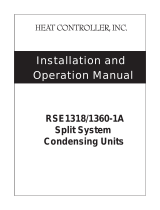
FORM 145.32-IOM4 (818)
8
GENERAL INFORMATION
Models 2 to 8 tons can be ordered as packaged,
factory-charged unitized packages or as factory split.
The 10 ton model comes factory-split. See ‘Cabinet
Configuration Options’ for more information.
Units can be turned on their side for short periods of
time, which allows passage through standard door
sizes. All unit components are securely mounted inside
the heavy gauge galvanized steel cabinet. All units are
lined with 1/2" thick - 2 lb density acoustical insulation
to ensure the quietest operation. All models are
provided with medium-efficiency 2" thick throwaway
filters rated MERV 7.
All units 2 to 5 tons utilize a single scroll compressor.
The 8 and 10 ton model is a dual scroll compressor unit
with two independent refrigerant circuits. All units come
standard with a microprocessor control board (refer to
‘Microprocessor’ section).
Units will operate reliably at outdoor ambient down to
50F. In applications requiring operation below this
temperature, a low ambient damper accessory is
available. The damper installs on the condenser air
intake, and allows operation to 0 F ambient.
ONLY QUALIFIED PERSONNEL SHOULD
PERFORM INSTALLATION AND SERVICE
OF THIS EQUIPMENT.
PRE-INSTALLATION INSPECTION OF EQUIPMENT
All units are factory tested to ensure safe operation and
quality assembly. Units are packaged and sealed on
shipping skids and shipped in first class condition. Torn
and broken packaging, scratched or dented panels
should be reported to carrier immediately. Internal
inspection of all units should be performed prior to
installation. Remove all access doors and check for
visual defects that can occur during transport. Any
problems found internally should be reported to carrier
and manufacturer immediately. Refrigerant circuit
should be checked to ensure no leaks have occurred
during shipment. Install gauge set to high and low
pressure ports to confirm pressure has been
maintained and no leaks have occurred during
shipment. Repair any damage prior to installation to
ensure safe operation.
RECORD ANY UNIT DAMAGE ON THE
BILL OF LADING AND REPORT TO
CARRIER AND FACTORY IMMEDIATELY.
SHIPPING AND HANDLING DAMAGES
ARE NOT WARRANTY ITEMS.
RIGGING
PRIOR TO MOUNTING UNIT, CHECK
INDIVIDUAL UNIT WEIGHTS (PAGE 10)
AND VERIFY LIFTING CAPACITY OF
LIFTING EQUIPMENT EXCEEDS WEIGHT
OF UNITS BY SAFE MARGINS. FAILURE
TO DO SO MAY RESULT IN UNIT
DAMAGE, PERSONAL INJURY OR EVEN
DEATH.
To ensure safe installation of the unit when ceiling
mount application is specified, estimate the
approximate center of gravity of the unit. The
configuration of internal components for each unit is
different and weight is unevenly distributed.
DETERMINE THE ACTUAL CENTER OF
GRAVITY OF THE UNIT BY PERFORM-
ING A TEST LIFT. LIFTING AN UNBAL-
ANCED UNIT CAN CAUSE PERSONAL
INJURY OR EVEN DEATH.
INSTALLATION SITE
LOCK ALL ELECTRICAL POWER SUP-
PLY SWITCHES IN THE OFF POSITION
BEFORE INSTALLING THE UNIT. FAIL-
URE TO DISCONNECT POWER SUPPLY
MAY RESULT IN ELECTRICAL SHOCK OR
EVEN DEATH.
Location - To ensure unit operates at maximum
efficiencies, choose a dry indoor area where the
temperature is controlled between 50F and 115F.
Consideration of surrounding areas should be taken
when choosing a location to install the unit. Common
vibration and sound levels associated with commercial
equipment may be objectionable to people or
equipment.
FAILURE TO ALLOW ADEQUATE SPACE
BETWEEN UNITS MAY RESULT IN POOR
UNIT PERFORMANCE AND POSSIBLE
UNIT FAILURE.
Install thermostats, air supplies and returns so that each
unit will operate only on individual unit control. To
assure fast drainage of condensate run-off, unit can be
slightly pitched in the same direction as drain pan outlet.






















